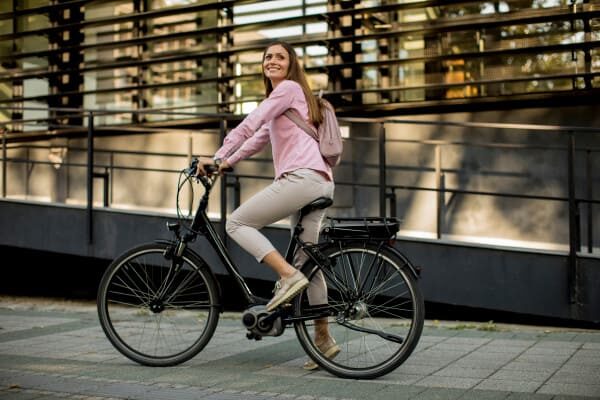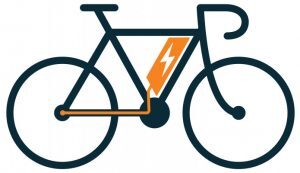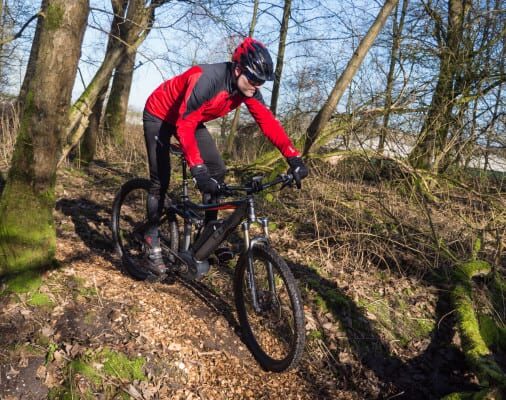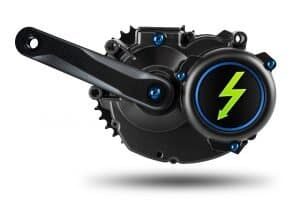
When you’re riding your electric bike, you want the experience to be as comfortable as possible. So to ensure this, it may be worthwhile considering suspension for your electric bike. When buying an electric bike, whether you have suspension can be an integral decision,
Suspension impacts your handling, comfort, fatigue, tire grip and even safety, whilst cycling. Also, having suspension increases the cost of your electric bike. Certain riding conditions benefit more from suspension than others. So whether you opt for suspension for your electric bike (and how much suspension), will depend on what conditions you want to ride in and your budget.
Here in this article, I will talk in length about suspension for electric bikes. This is to help you determine whether you feel suspension will be right for you.
Different Bike Options (With Regard to Suspension)
When deciding if you want suspension on your electric bike, there’s 3 different bike options. These 3 options are a rigid bike, a hardtail bike, or a full suspension bike. Below are definitions for these 3 bike options.
Rigid Bike
This type of bike has no suspension at all. Here, all you have is a rigid frame.
Hardtail Bike
Here, this type of bike has suspension, but only on the front of the bike and not at the rear. This front suspension is in the form of a suspension fork.
Full Suspension Bike
This type of bike has the most amount of suspension that you can get on a bike. Full suspension bikes have both front and rear suspension. The front suspension is again in the form of a suspension fork. The rear suspension consists of shock absorption technology within the bike’s frame.
Rigid Electric Bike Considerations
Cheaper, Fast and Light Option
Rigid bikes are cheaper and lighter than both hardtail and full suspension bikes. This is because they have no suspension at all, to add to their cost and weight. The lighter weight means that rigid bikes are easier to transport/carry, than the other 2 bike types. It also means rigid bikes are generally able to go faster than bikes with suspension.

Rigid bikes have no suspension to absorb any power generated from your pedal effort. This is another reason why they are generally able to go faster than bikes with suspension. However, the fact that electric bikes allow you to go faster, can mitigate any loss of speed due to having suspension. A consideration here, though, is that the less pedal effort lost to suspension, the less reliance on the electric motor. This can help your battery to last longer, to increase your range. By the way, your range is the distance your electric bike will travel before the battery runs out of charge.
Cost saving may be more crucial for you, when buying an electric bike. This is due to the fact that electric bikes are already higher in price than regular bikes.
Less Maintenance
Because rigid bikes have no suspension, there’s less parts to go wrong and maintain. Less maintenance will mean less cost in the running of your bike. Maintenance costs can include replacing and repairing parts. This is as well as bike shop charges for any tweaking, if needed. Also, you won’t ever need to concern yourself, with making sure the suspension is always set up correctly.
At the end of the day, rigid bikes allow for simplicity.
A Suitable Option for Smooth Surfaces
It can make sense to opt for a rigid bike if you don’t need suspension. This is due to the above mentioned advantages and simplicity of rigid bikes. You may consider that you don’t need suspension, if you know you’re only going to ride on smooth surfaces. This can be if you’re only going to be doing city riding. Whilst city riding, the roads and bike lanes/paths that you’ll be riding on, could be flat and smooth. You may consider the extra weight, maintenance and cost of having suspension unnecessary, here.

You May Have to Compensate for the Lack of Suspension Yourself
As rigid bikes have no suspension, you will feel every bump on the surface that you’re riding on. This can make these bikes uncomfortable, when riding on rough and uneven surfaces. To compensate for this, you may find that you’re lifting yourself off of your saddle whenever you come by any bumps, potholes, or curbs etc. You could also loosen your elbows and wrists to help here as well.
The above could help you still have a comfortable enough ride, without having to fork out for full suspension. This is more likely to work for you though, if most of your ride is on a smooth service, with the odd pothole, steep curb or uneven pavement slab, etc. here and there. If you’re lifting yourself off of your saddle often, whilst riding on rougher terrain, then this may be a nuisance.

Some Cyclists Prefer the Riding Experience of Rigid Bikes
It’s no surprise that rigid bikes are widely regarded as not ideal for riding on rough terrain. Even so, there’s still people who prefer riding rigid bikes, on rougher terrain. They enjoy the feedback and the feeling that they are more connected to what they’re riding on. Rigid bikes can make you feel that you’re taking on the terrain more, which some people can appreciate.
Even if you appreciate the feedback of rigid bikes on rougher terrain, this may be only so far though. A rigid bike is likely to be far too uncomfortable to ride on extreme rough terrain. It’s all down to rider preference though. If you do enjoy the feedback of rigid bikes, it’s recommended to buy one for this reason, rather than for cost saving. After all, you still want to enjoy cycling.
You Can Add Suspension Later
You may be intending to ride your electric bike in relatively smooth conditions only. However, you may still be unsure whether you’ll ride on unsmooth conditions at some point. This can leave you unsure about whether to pay more, to have suspension on your electric bike. You could pay extra for suspension, so that it’s there for if it’s ever needed, only to never need it.
An option here is you can buy a rigid electric bike and see how you go. You may determine later, that you could do with having some suspension. In which case, you can then buy and add a suspension fork to your electric bike.

Hardtail Electric Bike Considerations
Can be a Suitable Compromise Between Rigid and Full Suspension Bikes
As mentioned before, hardtail bikes only have suspension at the front. This allows them to act as a halfway house between rigid and full suspension bikes. You may find this a perfect solution if you want some suspension, but you don’t have the budget to buy a full suspension bike. Even if budget isn’t an issue, you may still prefer a hardtail. This can be if a hardtail electric bike will give you enough suspension for the surfaces that you’ll be riding on. In which case, a full suspension bike may be too excessive and you may deem there’s no point in paying the extra for it.

You may find a hardtail bike suitable, if you’re riding in urban conditions and on light off-road. Even riding in urban conditions, there can be enough uneven/rough road surfaces, potholes, steep curbs etc. to warrant at least front suspension. You’ll be getting that nice absorption at the front of the bike for these occurrences. You can still ride in these conditions without any suspension though. However, the suspension will make the ride comfier. After all, cycling is supposed to be enjoyable.
Hardtails allow you to avoid the extra weight, cost and maintenance of a full suspension bike. This is whilst still having some suspension.
Can Improve Your Off-Road Cycling Skills (Compared to Full Suspension)
This particularly applies to mountain bikers. If you’re mountain biking, then you would expect to be riding with either a hardtail, or a full suspension bike. Rigid bikes, typically aren’t suitable here, especially in extreme off-road conditions. Full suspension bikes make off-road trails far more comfier than hardtails. However, many mountain bikers still prefer hardtails. This is due to the fact that they feel that hardtails improve their riding skills.
The reason for this, is that hardtails allow you to pick your lines more, to avoid obstacles. They get you thinking in advance a lot more of the lines you pick, as you’re approaching obstacles. So the thinking here is that hardtails keep you on your toes more. For this reason, many mountain bikers, who are pro hardtail, feel that hardtails are best to start out on, if you’re new to mountain biking.

Full suspension bikes allow the tires to grip the surface you’re riding on better. This means you won’t get away with as much on a hardtail bike. So sometimes, when riding off-road on a hardtail, you’ll need better skills, to ride in the same places as a full suspension bike.
You Can Feel More Connected to the Trail
Mountain bikers that prefer hardtails, don’t like that having full suspension, makes you feel like you’re floating over obstacles. This, in their opinion, takes all the essence out of mountain biking. They like that hardtails allow you to feel every rock and bump more, so you feel more connected to the trail. The same as for why some people prefer rigid bikes (but usually in less extreme conditions), as mentioned before. This, along with that hardtails, cause you to pick your lines more, make hardtails more fun for some people.
This is another example, of where hardtails can be a suitable compromise, between rigid and full suspension bikes. Here, a rigid bike can be too uncomfortable and a full suspension bike can be too comfortable for some.
Speed Depending on Riding Conditions
Generally speaking, hardtails are slower than rigid bikes, but faster than full suspension bikes. This is as long as you’re not riding on rough, off-road terrain. The reason for this, is that less energy from your pedal effort is lost to the suspension, compared to full suspension bikes. Nonetheless, some energy from your pedal effort is still lost through the front suspension on hardtails. This is why, generally speaking, rigid bikes are faster than hardtail bikes. I say, generally speaking, because other features can affect the speed a bike can do, like its weight and design. This is another example of why hardtails can be a good compromise.

Hardtails are usually slower than full suspension bikes on rough, off-road terrain though. This is because full suspension bikes allow you to plough through obstacles. With hardtails, you’ll likely find you’re having to navigate your way (again pick a line) around obstacles. This will slow you down more. Also, full suspension bikes allow you to grip the surface you’re riding on better. This is another reason why hardtails are usually slower than full suspension bikes, on rough terrain. The better grip can give you the confidence to ride faster in extreme riding conditions.
Again, you can make up for any shortcoming in speed with a hardtail electric bike, with the electric boost. After all, providing extra speed is one of the reasons why people have electric bikes. Particularly, in riding situations that compromise speed.
Less Setup and Maintenance Compared to Full Suspension

Hardtails need less setup than full suspension bikes. This is due to that you only need to make sure that the front suspension fork is set up correctly. You haven’t got any rear suspension to make sure you have set up correctly, as well.
Having only the front fork, instead of full suspension, means less maintenance. There’s less moving parts to go wrong and repair, or replace, if ever needed.
All this makes hardtails simpler to deal with, compared to full suspension bikes. This is another reason why hardtails can be a suitable option, if you don’t need full suspension.
Can Leave You Feeling Battered
Hardtails can cause you to have more aches and pains the day after riding, compared to a full suspension bike. This is likely to not be such an issue on unchallenging terrain, but more of an issue on rough terrain. As much as some mountain bikers like that hardtails make you feel every bump more, you may still be feeling them the next day in a different way. You can be left with more aches in your wrists, knees and ankles, for example. Some cyclists may not mind this though and see this as a sign of a good session. Again, it’s all down to personal preference.
Motor Consideration (With Regard to Hub Motor)
Electric bikes will either have a hub motor, or a mid drive motor. Hub motors are situated on either the back, or the front wheel, of an electric bike. Mid drive motors are located in the center of the bike. My article, “Hub Motors Vs Mid Drive Motors” talks further about the differences between these 2 motor types. This, by the way, is to help you decide which of these 2 motor types, you’d prefer for your electric bike.
If you’re opting for a hardtail electric bike with a hub motor, then a rear hub motor is most ideal. This will give much better weight distribution on the bike, compared to a front hub motor. A front hub motor, combined with a suspension fork, will mean poor weight distribution. There will be far too much weight at the front of the bike, in relation to the rear. This will reduce the bike’s handling and control.

Considerations for Full Suspension Electric Bikes
Increased Comfort
Full suspension bikes isolate you from the bumps you ride over. This allows for a comfortable ride. This is important for many people, because as much as cycling can be for fitness and transportation, it should still be fun. Many people will vouch for the fact that riding a full suspension bike gives you a nice, smooth riding feel. You feel like you’re floating on a cloud, as the suspension absorbs every bump.
This increased comfort can turn out to be more important than you first realize, later on. If you find riding your electric bike uncomfortable, then this will reduce your enjoyment riding it. This can then lead to you riding it less and less, until you stop riding it altogether. Many people have ended up leaving their bikes gathering dust in their garage, for this reason. This, in turn, may mean that you’ll be exercising less.

A further consideration is that you may want an electric bike because it will help you to cycle more and further. In which case, comfort may be even more of a priority, if you’re making longer cycle journeys. Additionally, the faster you cycle, the more you feel the bumps you ride over. So considering that electric bikes help you to cycle faster, you may consider full suspension for an electric bike for this reason.
As full suspension is isolating you from bumps, it’s kinder to your joints, like your knees and wrists. This will mean fewer aches and pains for you.
Better for People with Injuries and Arthritis
Full suspension bikes, lend themselves to being suitable for people with injuries, or arthritis. This is due to the isolation they give you from bumps. So this is an instance where comfort is especially important. If you have a back injury, or arthritis, then feeling big bumps can be particularly unpleasant. It may even be very painful for you. Even feeling lots of little bumps can mount up.
This isolation from bumps you get with full suspension, can also prevent arthritis and injuries from being aggravated. Having arthritis, or an injury, may be the reason why you buy an electric bike in the first place. Riding an electric bike can be a great way to keep you fit, if you have either of, or both of these conditions. Having these conditions may make cycling inaccessible for you with a regular bike.
Provides Better Traction
Full suspension improves your bike’s traction. By the way, this traction is your bike’s tires grip on the surface they’re riding on, if you’re not sure. The suspension, absorbing every bump, means that the bike is not bouncing around. So both wheels will stay better connected to everything they ride over, with full suspension. This, in turn, improves your safety whilst cycling. Plus, you may not find it comfy, if your bike is bouncing over bumps.
This increased traction from full suspension, gives you better control and handling. This is especially at higher speeds. Bumps are far less likely to knock you off course from the line you’re riding in, with a full suspension bike. Again, this provides better safety.

More Weight and Reduced Efficiency
Having full suspension will make your electric bike heavier. This, combined with the fact that some of the energy generated from your pedal effort will be lost to the suspension, will reduce speed. Again, as mentioned before, though, having an electric bike allows your bike to go faster. The electric assisted boost can make up for any loss of speed, due to the extra weight and loss of pedal energy, caused by having full suspension.
Reduces Fatigue
Having no suspension, means that your legs and arms are absorbing the bumps you’re riding over. This increases fatigue, which mounts up over time, making long cycles more difficult. Due to this, some cross-country racing cyclists prefer to use full suspension bikes. A hardtail, or rigid bike, may be faster due to less/no pedal energy being lost to suspension. However, a full suspension bike can be far less fatiguing to ride over a long distance. This can allow cross-country racing cyclists to be faster on the later stages of the race.
Full suspension bikes, reducing fatigue, means they can benefit you whilst riding long distances, even if the terrain is not very rough. Remembering that even small bumps can mount up fatigue wise.

One consideration, though, is that electric bikes reduce fatigue anyway. This is due to the extra assistance they provide. So if you’re riding a hardtail or rigid electric bike, the electric boost will be negating any extra fatigue. The more electric boost you use, the more you drain the battery and reduce range though. This is a particular consideration for longer rides. However, intending to use the electric boost to reduce fatigue, could prompt you to decide on a hardtail, or rigid bike, to save money. At the end of the day, it all comes down to how you weigh things up.
More Setup and Maintenance
Having full suspension, means that you should ideally have it configured correctly. This is to get the best out of it. Both the rear and front suspension should operate in sync with each other.
Considerations with regard to your suspension setup, include rebound and the pressure and spring rate, in the front fork. Your ideal suspension settings will depend on your weight and the terrain you’re riding on. So your ideal suspension settings can change from ride to ride. This is particularly if you’re carrying cargo sometimes. There may only be a couple of different riding conditions that you ride in. In which case, there may only be a couple of different suspension setups that you’ll go between. So you may become familiar with these very quickly. If you’re always riding on the same terrain, you may rarely need to check your suspension setup.

Maintaining your ideal suspension setup is not especially hard though. It’s just knowing what to do in the first place. For some cyclists, this can all be part of the fun of cycling. This video talks in depth about managing your suspension set up.
talks in depth about managing your suspension set up.
Again, as mentioned before, full suspension means more maintenance. This video gives you advice on how to maintain your bike’s suspension.
gives you advice on how to maintain your bike’s suspension.
Be Careful of Cheap Full Suspension
Not all suspension is the same standard. A cheap in price full suspension bike, will likely be cheap in quality as well. It can be tempting to buy a cheap full suspension bike, but usually it won’t be worth it. The suspension will generally not work that great and the parts are more likely to break. You can sometimes find a cheap full suspension electric bike, for the same price as a good hardtail electric bike. Here, you’d usually be better off buying the good hardtail electric bike instead. This is because you’d be buying a better quality bike overall.
Generally speaking, you’re not likely to get a good quality full suspension electric bike for under $2000, or £2500. Around $3000, or £3500, is where you start to have really good quality suspension. I do say generally speaking though, as other features determine the price of an electric bike. These can include the power of the motor and battery capacity etc.
Improves Confidence and Riding Skills
Again, full suspension bikes provide extra traction and comfort over bumps, obstacles and rough terrain. Because of this, it may give you the confidence to ride on lines over off-road terrain and other places that you normally wouldn’t ride on. You’re not going to be bouncing around, which helps you to keep your feet on the pedals. This, in turn, helps with confidence.
This can be a counter-argument, against where some mountain bikers say that hardtails improve your riding skills. Many mountain bikers that are pro full suspension, argue that this extra confidence improves your riding skills. This is due to the fact that this extra confidence can allow you to take on tougher lines through terrain. Taking on tougher lines and more risks, can develop your riding skills this way.

Due to the above, mountain bikers that prefer full suspension, will argue that full suspension bikes just improve different skills to hardtails. Additionally, because of the extra traction that full suspension bikes provide, there is more margin for error. This can reduce setbacks, whilst riding on trails. More setbacks can reduce confidence, which, in turn, can hinder developing skills.
Having to pick your lines more on a hardtail, can have you all over the place a bit. So mountain bikers that are pro full suspension, will argue that you may not be riding on what they deem as the best lines on trails. Again, it’s all down to the individual as to which type of bike (suspension wise), best develops riding skills.
You Can Lock Out the Suspension
Some bikes allow you to lock out the suspension, so it’s disabled from use. Depending on the individual bike, you may either be able to fully, or mostly lock the suspension. This is handy, if you’re riding on a smooth surface and you don’t want any of the energy from your pedaling, to be lost to the suspension. Again, though, this may not be such an issue for you if you have an electric bike. Remembering that the electric boost can make up for any shortcoming in speed, due to having full suspension.

Improved Braking
Because full suspension bikes provide better traction, they lend themselves to better braking. This, in turn, improves safety. All the time the tires are staying planted to the surface better, the more effective the braking will be. This is more relevant for riding on uneven and rough surfaces. On smooth surfaces, the wheels should be well planted to the surface on any bike.
Motor Choice Considerations
As mentioned before, electric bikes will either have a hub motor or a mid drive motor. Remember that mid drive motors are located in the center of the bike. Hub motors are either on the front or back wheel. This means that mid drive motors allow for better weight distribution on electric bikes. So this compliments having full suspension. You’d have suspension at the front and back of the bike, with the mid drive motor in the middle. This will allow for a well-balanced bike. So generally speaking, mid drive motors are the more suitable motor type, for full suspension electric bikes.
Having a hub motor can give you too much weight on one end of the bike. For example, if you have a hub motor on your rear wheel, then you’ll have the weight of your rear suspension and motor, at the back of your bike. You’ll have more weight pulling you back, which will mean more effort riding up hills. This is in terms of both pedaling and motor effort, which will use up more battery. As mentioned before, better weight distribution on the bike, allows for better handling and control.

I do say that mid drive motors are more ideal for full suspension electric bikes, generally, though. This is because you may have your own personal reason why a hub motor may be better for you. Again, this article talks further about the differences between hub motors and mid drive motors. Mid drive motors are higher priced than hub motors though, so they’ll add more cost to your electric bike. They do provide you with more torque than hub motors though.
Additionally, hub motors tend to make the wheel they’re situated on bounce around more. So if you do have a hub motor on a full suspension electric bike, then at least the suspension will mitigate this issue.
Electronic Suspension
There are electric bikes available that have electronic suspension. The idea here is to prevent you from having to manually set up your suspension. This takes out the guesswork and creates simplicity. Ultimately, this can mean less hassle for you.
The electronic suspension works by having sensors that identify changes in the terrain that you’re riding on. It then adjusts the suspension settings accordingly, when needed.

Some cyclists do prefer manually setting up their suspension though. This can be because the electronic suspension may not take certain considerations into account. For example, it doesn’t take into account your riding position, bike size, or whether there’s any extra weight, like cargo. You may be riding in a forward riding position, so your weight is at the front. Here, the electronic suspension may think the front fork is too soft. So electronic suspension can be not real world enough for some people.
You may be perfectly happy enough with manually setting up your suspension anyway. So the extra cost that electronic suspension adds to your bike, may not be justified. Also, you may prefer the predictability of manual suspension setup. The suspension being set up to how you decide and not what an electronic system decides, may suit you better.
Ultimately, electronic suspension is something that is available, if you decide on it.
Suspension Alternatives
There are a couple of alternative options to suspension. These give some of the benefits of suspension, whilst avoiding the disadvantages of it, like extra cost and maintenance. These options could prompt you to buy a hardtail, instead of a full suspension bike. Similarly, they could prompt you to buy a rigid bike, instead of a hardtail. You can even use these options in conjunction with suspension. I discuss these options below.
Thick Tires
Having thick tires on your electric bike can absorb the impact from the bumps you ride on. How well they do this, depends on the terrain you’re riding on and the thickness of the tires. Full suspension is still generally more effective at absorbing bumps though. So thick tires may only be so effective on extreme off-road conditions. However, on any terrain that is not too extreme, then thick tires can do a good enough job. Thick tires also improve traction as well.
You can even get fat bikes. These bikes have especially thick tires. They are made with riding in more extreme conditions in mind. However, many cyclists enjoy riding these bikes in urban conditions. The good news is, you can get electric versions of these bikes.

Suspension Seatposts
You can always buy and then attach a suspension seatpost to your electric bike. These can do a very good job at isolating you from bumps, whilst cycling. These will not help improve your bike’s traction though, like what suspension does. However, they do improve your comfort whilst cycling. This video talks further about suspension seatposts.
talks further about suspension seatposts.
Conclusion
There’s not necessarily any right, or wrong answer as to whether you should have suspension. It’s all down to personal preference and what riding scenarios you wish to use your electric bike for. Good suspension allows for a comfortable cycle. This, in turn, helps with the enjoyment of cycling. However, buying a full suspension electric bike isn’t cheap. Opting for a hardtail and/or a suspension seatpost and thick tires, can often act as a suitable alternative.
Remember, full suspension may not be necessary for your cycling needs anyway. This is great if you don’t have the budget for a full suspension electric bike. You may even be someone where budget is not an issue, but still has no need for full suspension. However, you may like the idea of having full suspension, in case you need it sometime in the future.
Hopefully, I’ve given you enough information in this article, to help you decide which suspension option for your electric bike is best for you.